>
Anguilliformes (Eels and morays) >
Ophichthidae (Snake eels) > Myrophinae
Etymology: Myrophis: Greek, myros, -ou = male of morey eel + Greek, ophis = serpent (Ref. 45335).
More on authors: McCosker, Böhlke & Böhlke.
Environment: milieu / climate zone / depth range / distribution range
Ecologia
marino demersale; distribuzione batimetrica 0 - 1 m (Ref. 58018). Tropical
Western Central Atlantic: Colombia.
Size / Peso / Age
Maturity: Lm ? range ? - ? cm
Pale yellow to tan with tiny dark spots on snout, nape and body above lateral line. Dorsal fin origin only 1-2 pectoral fin lengths behind gill opening (Ref. 26938).
Life cycle and mating behavior
Maturità | Riproduzione | Deposizione | Uova | Fecundity | Larve
Eschmeyer, W.N. (ed.), 1998. Catalog of fishes. Special Publication, California Academy of Sciences, San Francisco. 3 vols. 2905 p. (Ref. 26282)
IUCN Red List Status (Ref. 130435: Version 2024-1)
Threat to humans
Harmless
Human uses
Strumenti
Special reports
Download XML
Fonti Internet
Estimates based on models
Preferred temperature (Ref.
123201): 27.1 - 28.5, mean 27.8 °C (based on 115 cells).
Phylogenetic diversity index (Ref.
82804): PD
50 = 0.5078 [Uniqueness, from 0.5 = low to 2.0 = high].
Bayesian length-weight: a=0.00076 (0.00029 - 0.00197), b=3.06 (2.83 - 3.29), in cm total length, based on LWR estimates for this (Sub)family-body shape (Ref.
93245).
Trophic level (Ref.
69278): 4.1 ±0.7 se; based on size and trophs of closest relatives
Resilienza (Ref.
120179): Alto, tempo minimo di raddoppiamento della popolazione meno di 15 mesi (Preliminary K or Fecundity.).
Fishing Vulnerability (Ref.
59153): Low to moderate vulnerability (28 of 100).
